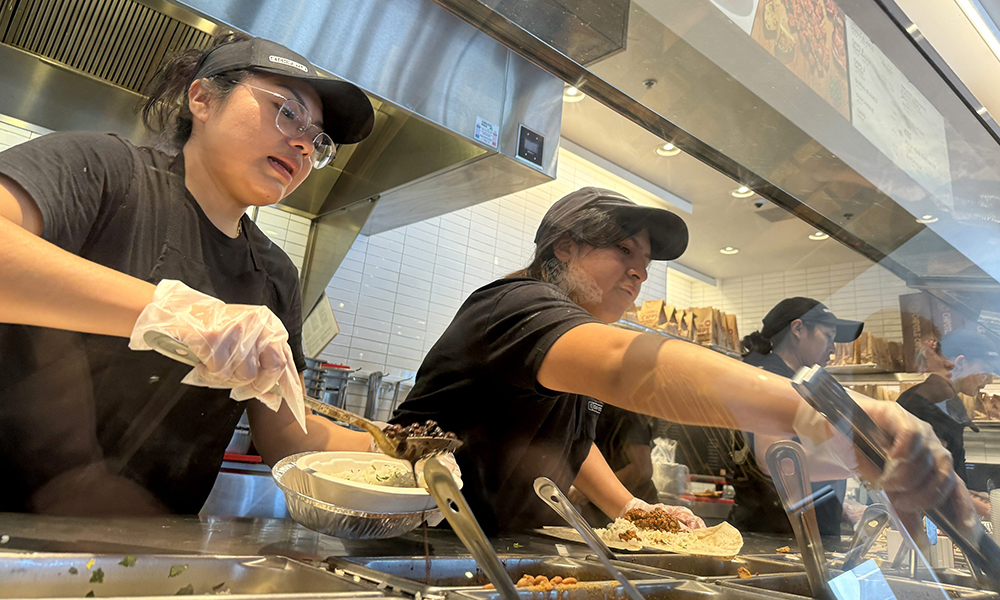
美国加州要求将快餐业员工的最低时薪从15.5美元上涨到20美元,这项突破性法律在今年4月初正式生效,Chipotle、Chick-Fil-A、必胜客(Pizza Hut)和Jack in the Box等连锁餐厅随后纷纷警告顾客,预计备受欢迎的玉米饼或玉米片将会涨价。
如今,这些警告变成了现实:市场调研公司Datassential的一份报告显示,自2023年9月通过和今年4月1日正式生效的新最低工资法律出台以来,多家大型连锁快餐厅的汉堡、玉米饼或薯条纷纷涨价。自2023年9月以来,加州的物价上涨了7%,领跑全美。
今年,美国共有22个州提高了最低工资,有近1,000万工人受益。提高最低工资的好处包括帮助低收入工人获得足够的工资,在通胀导致全美生活成本大幅上涨的情况下能够维持生计,还可以缩小性别、种族和民族工资差距,因为赚取最低收入甚至工资水平更低的群体,主要是有色人种。但提高薪酬本身也是问题的一部分,因为除了食物价格上涨外,公司还需要面对更高的人工成本,现在它们通过涨价将这些成本转嫁给了消费者。
许多公司选择了涨价。Chipotle在上周对投资者表示,4月第一周,加州近500家连锁餐厅的菜单价格,与2023年同期相比上涨了6%至7%。戈登哈斯克特研究顾问公司(Gordon Haskett Research Advisors)的研究显示,加州Chick-fil-A餐厅的平均价格,自4月初以来上涨了超过10%。一位必胜客的特许经营商称工资上涨是必胜客不得不先发制人选择裁员的原因,今年,必胜客将在加州裁减1,000多名送餐员。
戈登哈斯克特公司的数据显示,从今年2月中旬到4月中旬,加州许多受欢迎的连锁餐厅纷纷涨价。据美国劳工统计局(Bureau of Labor Statistics)统计,在这两个月内,星巴克(Starbucks)、Shake Shack、Chipotle和塔可钟(Taco Bell)均涨价约5%,而全美餐厅平均仅涨价0.4%。
Chipotle、Chick-fil-A、塔可钟和Shake Shack均未回应《财富》杂志的置评请求。
美国劳工统计局的报告显示,加州有全美最多的快餐业员工,其次是得州、佛罗里达州和纽约州。现在加州为快餐业员工提供业内最高的基本工资保证;其他行业的工作者同样享有国内最高的最低工资之一,为每小时16美元。
许多赚取最低工资的员工确实需要涨薪。经济政策研究所(Economic Policy Institute)的报告显示,美国现在准备迎接涨薪的近1,000万名员工中,有超过一半是女性;有接近四分之一或约250万是需要养家的上班族父母;超过50%目前的收入水平低于贫困线。
经济政策研究所认为,随着最低工资上涨,政府在低收入工人福利[例如补充营养援助计划(Supplemental Nutrition Assistance Program)]方面的支出和在劳动所得税抵免与儿童税收抵免方面的支出,将减少数十亿美元。
加州最近的立法,还引起了被排除在新最低工资标准以外的其他食品行业的警觉,尤其是该州的学校食品服务业。历史上,食品服务工人是公立学校收入最低的雇员,但随着加州率先为该州620万公立学校的学生提供免费餐,对食品服务工人的需求旺盛,而快餐业提高薪酬将迫使许多学校不得不跟着涨薪。
2023年,萨克拉门托统一校区(Sacramento Unified School District)将食品服务工人的工资提高了10%,7月再次上涨了6%,达到每小时20美元。美联社(AP)的报道称,这是该校区近三十年来最大幅度的一次涨薪。美联社指出,随着更多的学生选择在学校用餐,一个南加州的校区将食品服务人员的数量增加了一倍,达到40人,但其他校区,包括洛杉矶县的一个校区,发现它们没有能力为食品服务工人提供适当的工资。一位校区官员对美联社表示,食品服务工人的时薪可能高达25.51美元,但他们每天只工作三个小时,而且没有资格享受健康福利。(财富中文网)
译者:刘进龙
审校:汪皓
美国加州要求将快餐业员工的最低时薪从15.5美元上涨到20美元,这项突破性法律在今年4月初正式生效,Chipotle、Chick-Fil-A、必胜客(Pizza Hut)和Jack in the Box等连锁餐厅随后纷纷警告顾客,预计备受欢迎的玉米饼或玉米片将会涨价。
如今,这些警告变成了现实:市场调研公司Datassential的一份报告显示,自2023年9月通过和今年4月1日正式生效的新最低工资法律出台以来,多家大型连锁快餐厅的汉堡、玉米饼或薯条纷纷涨价。自2023年9月以来,加州的物价上涨了7%,领跑全美。
今年,美国共有22个州提高了最低工资,有近1,000万工人受益。提高最低工资的好处包括帮助低收入工人获得足够的工资,在通胀导致全美生活成本大幅上涨的情况下能够维持生计,还可以缩小性别、种族和民族工资差距,因为赚取最低收入甚至工资水平更低的群体,主要是有色人种。但提高薪酬本身也是问题的一部分,因为除了食物价格上涨外,公司还需要面对更高的人工成本,现在它们通过涨价将这些成本转嫁给了消费者。
许多公司选择了涨价。Chipotle在上周对投资者表示,4月第一周,加州近500家连锁餐厅的菜单价格,与2023年同期相比上涨了6%至7%。戈登哈斯克特研究顾问公司(Gordon Haskett Research Advisors)的研究显示,加州Chick-fil-A餐厅的平均价格,自4月初以来上涨了超过10%。一位必胜客的特许经营商称工资上涨是必胜客不得不先发制人选择裁员的原因,今年,必胜客将在加州裁减1,000多名送餐员。
戈登哈斯克特公司的数据显示,从今年2月中旬到4月中旬,加州许多受欢迎的连锁餐厅纷纷涨价。据美国劳工统计局(Bureau of Labor Statistics)统计,在这两个月内,星巴克(Starbucks)、Shake Shack、Chipotle和塔可钟(Taco Bell)均涨价约5%,而全美餐厅平均仅涨价0.4%。
Chipotle、Chick-fil-A、塔可钟和Shake Shack均未回应《财富》杂志的置评请求。
美国劳工统计局的报告显示,加州有全美最多的快餐业员工,其次是得州、佛罗里达州和纽约州。现在加州为快餐业员工提供业内最高的基本工资保证;其他行业的工作者同样享有国内最高的最低工资之一,为每小时16美元。
许多赚取最低工资的员工确实需要涨薪。经济政策研究所(Economic Policy Institute)的报告显示,美国现在准备迎接涨薪的近1,000万名员工中,有超过一半是女性;有接近四分之一或约250万是需要养家的上班族父母;超过50%目前的收入水平低于贫困线。
经济政策研究所认为,随着最低工资上涨,政府在低收入工人福利[例如补充营养援助计划(Supplemental Nutrition Assistance Program)]方面的支出和在劳动所得税抵免与儿童税收抵免方面的支出,将减少数十亿美元。
加州最近的立法,还引起了被排除在新最低工资标准以外的其他食品行业的警觉,尤其是该州的学校食品服务业。历史上,食品服务工人是公立学校收入最低的雇员,但随着加州率先为该州620万公立学校的学生提供免费餐,对食品服务工人的需求旺盛,而快餐业提高薪酬将迫使许多学校不得不跟着涨薪。
2023年,萨克拉门托统一校区(Sacramento Unified School District)将食品服务工人的工资提高了10%,7月再次上涨了6%,达到每小时20美元。美联社(AP)的报道称,这是该校区近三十年来最大幅度的一次涨薪。美联社指出,随着更多的学生选择在学校用餐,一个南加州的校区将食品服务人员的数量增加了一倍,达到40人,但其他校区,包括洛杉矶县的一个校区,发现它们没有能力为食品服务工人提供适当的工资。一位校区官员对美联社表示,食品服务工人的时薪可能高达25.51美元,但他们每天只工作三个小时,而且没有资格享受健康福利。(财富中文网)
译者:刘进龙
审校:汪皓
When California’s groundbreaking law raising fast-food workers’ minimum wage from $15.50 per hour to $20 took effect at the start of April, food chains including Chipotle, Chick-Fil-A, Pizza Hut and Jack in the Box warned customers to expect higher costs for that go-to burrito or slice.
Those warnings are now materializing: prices for a burger, burrito, or fries at several big fast-food chains have jumped since the new minimum wage was signed into law in September, taking effect on April 1, according to a report by market research firm Datassential. Since September, the state’s prices have risen 7%, leading the nation.
This year, 22 states have raised their minimum wage, affecting nearly 10 million workers. The benefits of a higher minimum wage include helping low-income workers earn enough to live on as inflation drives the cost of living higher all over the country and closing gender, racial and ethnic wage gaps, because people of color are overrepresented among those earning the minimum or less. But better pay is also part of a problem, since businesses need to front higher labor costs on top of rising food prices—and are now shifting that cost onto consumers through price hikes.
Those hikes are many. Chipotle told investors last week that prices at nearly 500 of its California chains increased between 6% and 7% across its menu during the first week of April, compared to the same time last year. At California Chick-fil-A locations, prices have increased by over 10% on average since the start of April, according to research by Gordon Haskett Research Advisors. One Pizza Hut franchisee cited the wage hike as the reason for a preemptive wave of layoffs, in which more than 1,000 delivery drivers will be cut this year across the state.
According to Gordon Haskett’s data, prices at many popular chains in California rose from mid-February to mid-April. Prices at Starbucks, Shake Shack, Chipotle and Taco Bell all jumped by roughly 5% in those two months, while restaurant prices nationwide rose just 0.4%, according to the Bureau of Labor Statistics.
Chipotle, Chick-fil-A, Taco Bell and Shake Shack did not respond to Fortune’s request for comment.
California employs more fast food workers than any other state in the country, according to a Bureau of Labor Statistics report, followed by Texas, Florida and New York. California now offers fast food workers the highest guaranteed base salary in the industry; for all other workers, it also offers one of the highest minimum wages in the country, at $16 per hour.
To be sure, for many minimum wage workers, the pay raises are needed. Of the nearly 10 million workers in the country who are now set to receive raises, women make up over half; nearly a quarter of them, or roughly 2.5 million, are working parents with families; and over 50% of workers getting raises currently earn incomes below the poverty line, according to a report by the Economic Policy Institute.
With a higher minimum wage, government spending on low-income worker benefits like the Supplemental Nutrition Assistance Program (SNAP) and spending on earned income tax credit and child tax credits could drop by billions, according to EPI.
California’s recent legislation has also spurred alarm among other food sectors excluded from the new minimum wage standard, notably the state’s school food service industry. Food service workers historically are some of the lowest-paid employees in public schools, but are now in high demand after California became the first state to offer free meals for all 6.2 million public school students in the state—and the higher wages from fast food jobs are forcing many schools to up their pay.
Last year, Sacramento Unified School District increased wages for its food service workers by 10%, hiking another 6% in July to bring workers to $20 per hour. According to an AP report, it was the district’s largest single raise in nearly three decades. A Southern California school district doubled its food service staff to 40 people after more students were eating school meals, the outlet reported, but other districts, like one in Los Angeles county, found they couldn’t afford to pay their food service workers a comparable wage. A district official told the AP food-service workers could earn up to $25.51 per hour, but would only work three hours per day and be ineligible for health benefits.






